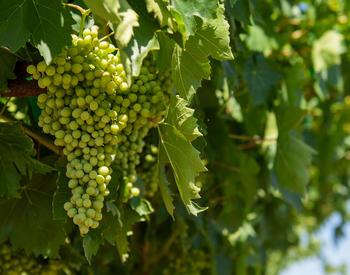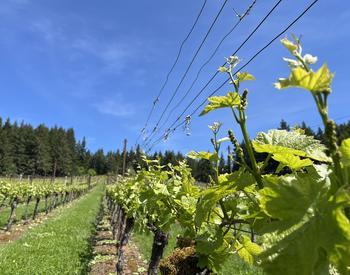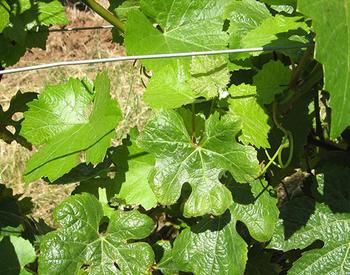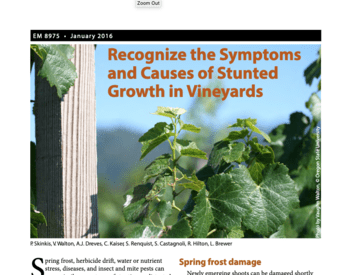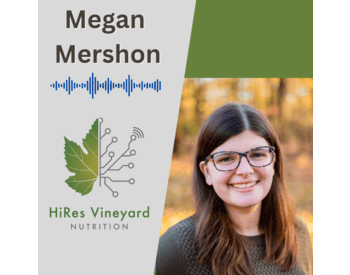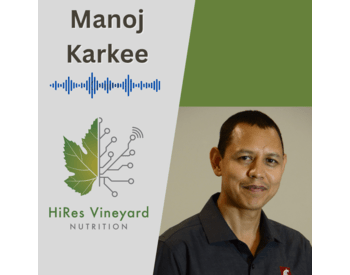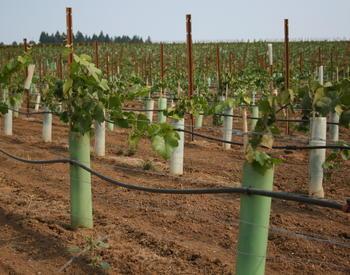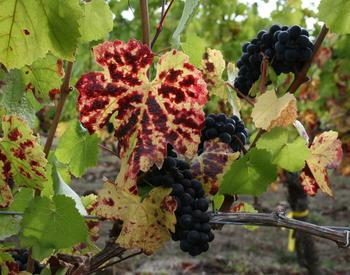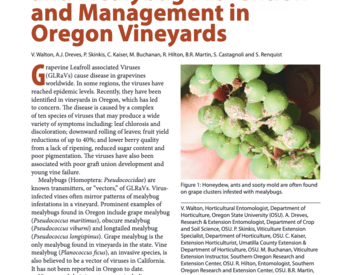Transcript
(00:00:00) Patty Skinkis
This is the High-Res Vineyard Nutrition Podcast, devoted to helping the grape and wine industry understand more about how to monitor and manage vineyard health through grapevine nutrition research. I am your host, Dr. Patty Skinkis, Professor and Viticulture Extension Specialist at Oregon State University.
(00:00:22) Patty Skinkis
To evaluate vineyard nutrition status, many growers collect petioles during bloom and send them off to a lab for analysis. A week or so later, a report is produced with critical values to interpret whether the vineyard has sufficient nutrient levels or deficiencies. Where do those comparator numbers come from? Well, much of the vineyard nutrition research and practical guidelines for growers was developed by Dr. Pete Christensen, a former viticulture extension specialist with the University of California Cooperative Extension. He served in Central California as the premier expert on vineyard nutrition and is known across the globe for his ability to determine plant nutrient stress. The research he did in determining nutrient sufficiency or deficiency levels for grape vine tissues that we use today in evaluating whether vines have adequate nutrient status came from his work. Much of the California interpretations for nitrogen, potassium, zinc, and boron, were based on Pete’s work, and I argue that the majority of the U.S. probably uses his standards in their evaluation of grapevine tissues for nutrient deficiency or sufficiency. While we recognize the importance of Dr. Christensen's early work, we also recognize that there are more questions to explore with vineyard nutrient status, and the different teams in the HiRes Vineyard Nutrition Project are addressing these vine nutrient status questions across the U.S., including partners in New York, Virginia, Washington, Oregon, and California. Today's episode will focus on continued work being conducted on vine nutrition in California.
Joining us today is Dr. Matthew Fidelibus, Cooperative Extension Specialist focusing on viticulture for the University of California Davis Cooperative Extension Service. He works at the UC Kearney Agricultural Center located in Parlier, California. He’s the successor to Dr. Pete Christensen. Dr. Matthew Fidelibus develops research and extends his findings to growers so they may reduce production costs while improving yield and quality for both raisin, table, and wine grapes in California. This is no minor feat. Matt joined the HiRes vineyard nutrition project as the sole co-PI working on table and raisin grape nutrition research. He is involved in the plant nutrition and crop quality team as well as the outreach team of the project. Matt conducts applied and basic research on raisin, table, and wine grapes and has been doing so for almost two decades. He earned his bachelor's degree in biology from San Diego State University, and MS in plant science from Arizona State, and his PhD in horticultural sciences from the University of Florida. Matt has a strong publication record and has worked on many areas of vineyard production from nutrition to evaluation of cultivars, new methodologies such as dry-on-the-vine for raisin producers, to testing the impacts of plant growth regulators. He's well accomplished in his outreach serving as an innovator for extension outreach in social media and doing this well before many others had done so. He was awarded the Extension Distinction award by the American Society for Enology and Viticulture in 2015, and we're pleased to have him join us today.
(00:03:28) Matthew Fidelibus
Thank you, nice to be here.
(00:03:30) Patty Skinkis
So, Matt I was hoping that you could talk to us a little bit about how the table raisin and wine grapes differ from this standpoint of nutrition. Do they have different nutritional needs?
(00:03:44) Matthew Fidelibus
Well, that was a question that the table grape commission posed to us several years ago, and by us, myself and Larry Williams. Let me take a step back and talk about the situation with nitrogen and the San Joaquin Valley. The San Joaquin Valley relies heavily on groundwater, especially during drought years, and the groundwater has become contaminated in some places with nitrates, and that's affecting not just agriculturalists but also people in urban areas. So there has been regulations put in place to better understand what the nitrogen needs are of your crop and to ensure that you're not over applying nitrogen. That you're applying an appropriate amount. So, the Table Grape Commission was interested in refreshing the information that we knew about table grape nutrition. There is a lot of work that's been done on grapevine nutrition in California, as you pointed out in your introduction, by Pete Christensen, who was primarily working on traditional raisin grape vineyards, which would be Thompson Seedless, and using production systems that were less productive than current systems. We needed to take a look and see whether these newer varieties on larger trellises and producing a lot more fruit have a different nutrition demand than old raisin vineyards. What we did is, we went and did a lot of research. Some of it was observational, some of it was research-based. We visited many different vineyards, either we collected tissue samples throughout the year or we varied the fertilizers applied in those vineyards and collected tissue samples. Our goal was to get a better understanding of the biomass that we were dealing with in these various vineyards over the course of the season, and what the nitrogen and other mineral nutrient contents were in those tissues. From that, we've been able to develop nitrogen budgets for the different table grapes, and we've also been looking at how that relates to tissue and sample data. For example, petioles or blades. That's the kind of work that we've been doing to come up with refreshed information that growers can use to have a better understanding of what their nitrogen needs are.
(00:06:24) Patty Skinkis
Are there other nutrients that are of particular concern other than the nitrogen having obvious links to groundwater contamination and environmental contamination? Are there concerns about phosphorus or potassium?
(00:06:39) Matthew Fidelibus
Yes, we've been primarily working on nitrogen because there it's the mineral that is in the most demand in this area and also because of the environmental regulations pertaining to nitrogen. It was important for both of those reasons to have a better understanding of how new varieties and new trellis systems and new cropping systems affect nitrogen, but there are other nutrients that can be a concern to growers in the Valley. Besides nitrogen, potassium is one that is used in large amounts by growers, and so we've been collecting some potassium data as well to accompany the nitrogen. Zinc deficiency is something that's relatively common in the San Joaquin Valley, and in some varieties a foliar application of zinc is common or normal practice. Particularly, certain rootstocks, like Freedom, tend to be poor at taking up zinc. So, if you have a variety that tends toward zinc deficiency, you might have to pay special attention to your rootstock, and also just to ensure that you're always applying zinc every year.
Boron is an interesting micronutrient that is commonly deficient in some parts of the San Joaquin Valley and commonly toxic in other parts of the Valley. So, it depends on the parent material of the soils and the groundwater quality in those different areas as to whether you're likely to have toxicities or deficiencies.
Magnesium deficiency, I would say is the other deficiency that is, I wouldn't say it's common, but it's not uncommon. It is pretty easy if someone wanted to see magnesium deficiency it wouldn't be hard to show someone in this area. So, zinc, boron, nitrogen, potassium, those are all things [nutrients] that people regularly apply or at least pay attention to every year. Magnesium deficiency is something that, in the past, has been ignored because on less productive vineyards, like Thompson Seedless raisin vineyard, it normally wouldn't be a big problem. You would see some magnesium deficiency maybe in the middle of the summer or end of the summer basically. You'd see some but it'd be like a little bit of chlorosis on the basal leaves, and it didn't really seem to correlate with yield in any way. So, was recommended just to kind of watch it. You probably don't really have to treat it or maybe just spot treat it. But lately it seems that we're seeing it more and more with more frequency especially on these newer varieties and I'm not sure if it's a variety issue or if it's just a change in the soils over time or maybe a combination of both or also the higher cropping that we have is depleting more. There are various hypotheses as to why it might be more prevalent now than it has been in the past but it's common enough now. It's becoming more common that people want to take a second look at that and so we started collecting those data as well, and I think we have the information now to put together a budget for some of these other nutrients that we haven't necessarily been purposely altering. But, at least we can see what is a typical or normal or at least a range of values in the different parts of the plant at different times the year.
(00:10:23) Patty Skinkis
I think you bring up a really good point that perhaps many don't think about in using standards that have remained the same over time, is that we do change how we do things. Different rootstocks, exploring new regions that grapes are produced in, new cultivars, all of this play an impact on the nutrient status. So, it's great to see that this work is continuing.
I know that a lot of the project collaborators are testing different tissues and different time points to come up with some of those nutrient recommendations. What methods are most commonly used by table and raisin grape growers, or even wine grape growers, in your region to determine their nutrient status? Is there a certain time point and tissue that they prefer over another?
(00:11:10) Matthew Fidelibus
Well, most of our monitoring I think on a regular monitoring… the kind of year to year, day to day monitoring… is done with tissue samples. Historically the tissue that's been most commonly tested is petioles. So, at bloom time, it's a petiole opposite of a cluster. At veraison, we take petioles from recently matured leaves, so we're generally moving up the stem as compared to earlier in the season. But there's also interest in growers in having standards for leaves [leaf blades] as well. It is recognized that certain mineral nutrients like boron, tend to accumulate in leaves over the course of the season and maybe testing leaf blades is a better indicator of potential problems with the minerals that tend to accumulate over the course of the season. Some of these other minerals like nitrogen tend to actually become less concentrated in the tissues over time, but other minerals tend to become more concentrated. Anyways, I think that you're seeing more and more interest in leaf blades, but the foundation of monitoring methods was based on petioles, and so there's some momentum behind petioles and there's history. Pete Christensen often pointed out in his recommendations that tissue sampling becomes more useful to growers if they keep annual records and do it regularly because that gives you feedback that you can compare to; you’re almost doing your own trials. You're collecting fruit yield and quality and also tissue samples from year to year. You have records of your nutrition program and you can get a sense over time about how your cultural practices, including fertilization and crop levels, affect the demand for these various nutrients, and you'll see changes in the tissues within your vineyard that can give you an indication of whether you might need to revisit your fertilization strategy. We encourage people to do the same, and because there's a long history of information with petioles in the San Joaquin Valley, it's hard to abandon that sampling strategy. So, one thing that I've encouraged people to do if they prefer to have blades is to collect both for several years and get a sense for themselves within their own vineyard about how the nutrients that they have been monitoring compare to petioles versus blades.
The other thing I would point out is Peter Christensen put a lot of weight on nitrate nitrogen and petioles, but nitrate nitrogen is almost undetectable in blades. So, if you are accustomed to thinking in terms of nitrate nitrogen and then you switch to blades, you're not really going to have a good comparison there. The other thing, the total nitrogen content of petioles tends to be a lot lower than the total nitrogen of blades. So again, even there it would be good to collect split samples for a while, if you're thinking about transitioning to blades and see for yourself which method is meeting your needs or that you're more comfortable with. If nothing else, then at least you have a bridge there of a couple of years of data that can get you to see how one compares to the other. If you just switch over from petioles to blades, it can be hard for you to understand what you're seeing [in the analytical results]. So, I think it's good to not switch tissue sampling techniques too hastily.
(00:15:13) Matthew Fidelibus
You mentioned to me early, before we started the podcast, that you were going to be speaking with one of my collaborators, Alireza Pourreza, who is a professor at Davis at the Agricultural Engineering Department. He and I have been thinking about the concept of tissue sampling and remote sensing and how they relate to each other and how that can be used to manage vineyards better in terms of nutrition. The reason why I'm bringing this up is that the tissue samples we're taking is a sample of tissue. It's a standardized sample. For example, a petiole opposite a cluster at bloom. And that's good in that it helps reduce the variation that might occur from season to season. For example, you only harvested on a calendar date as compared to a developmental period. So, it's good to have these standard samples, and of course if you were to take samples up and down the stem at different positions, you would see different nutrition results. So, that's the reason why we choose these standard sampling techniques. It allows a grower more easily to look at year-to-year differences in their practices and see how that might be affecting their nutrition by removing some sources of error.
(00:16:35) Mathew Fidelibus
When we were first thinking about remote sensing as something that could either complement or perhaps even replace traditional tissue samples, we were thinking of bridging the gap there. Some people collect nutrition data from blades, and so it would be interesting to see if we could estimate nitrogen content or content of other nutrients from remote sensing of blades. It's pretty hard to remote sense, get reflectance off of petioles, for example, so blades are much bigger target for us, and so that's why we were keying in on blades. Instead of submitting the leaf blade to a lab, we can just get the reflectance to the leaf blade. But maybe the next step is to measure the whole canopy's reflectance and relate that to the whole canopy nutrition content--between that and other kinds of sensing that Alireza will be much more expert at than me. We have been trying to relate biomass and also nutrient content by remote sensing, and the idea there is maybe we could pretty rapidly develop nitrogen demand maps of the vineyard. That might be a more direct way of suggesting changes to someone's nutrition content than just relating the nutrition content of a petiole to something because now we're actually being able to directly measure nitrogen in the annual growth at different stages to say this is how much you accumulated from the start of the season to now in your canopy. I think that would be more useful, perhaps, to growers than just looking at a tissue sample.
I was just looking at some tissue samples that a grower sent me this morning who's having a physiological problem that might be related to nutrition, and it was striking to me how radically different his nitrate and nitrogen levels were from one year to the next. So we've been trading emails this morning trying to understand why that might be. But, I have a feeling that if we could measure the nitrogen content in the tissues of a whole vine, it would probably be less variation from year to year and particularly as you get later into the season. So, we're not there yet; I don't want to suggest that we're able to do this now, but this is kind of where I think we want to be going [in the research].
(00:19:13) Patty Skinkis
So, basically the research you're doing is including, not just singular sample correlation to a sensor, but rather whole plant correlation?
(00:19:23) Matthew Fidelibus
We're doing both. So, we have been collecting all the leaves on some shoots, combining them for example into a pool, to get a sense for how much nitrogen is in all the leaves in the canopy and also the biomass of the leaves. We're also collecting traditional samples at the same time, like opposite a cluster. Then we are also collecting and individual leaves on a shoot and measuring nitrogen content in them separately. We have some pretty interesting results looking at the individual leaves along a shoot, and I think that this is something that we have to think about because the nitrogen content in the leaves in different positions is different. In a canopy over time, you start to develop lateral shoots and you have primary shoots, and you end up with quite an arrangement of leaves at different ages, and I think that that could be a source of error that we need to figure out how to understand in order to sense nitrogen of the whole canopy at once. But, even with those potential sources of error, my colleague, Dr. Pourreza, has developed some pretty strong algorithms. We were able to develop a sample map of a vineyard showing different areas that have higher or lower nitrogen content. So, there's potential there, but there's also significant sources of error that we need to understand better. Hopefully we can use that understanding to improve the algorithms further.
(00:21:05) Patty Skinkis
I think you bring up some really interesting perspectives on just the methodology as researchers to look at comparing the tissues to whole plant. What's been done in the past versus the future, and I know the different teams throughout the United States are using slightly different but similar methodologies. I think almost everybody's doing leaf blade and petiole. Everybody's doing some form of correlating that to some sensor evaluations. But I'm not sure that everybody's doing the whole plant component, which I think brings in that biomass as you said. Looking at the whole plant, which we've always said to growers, “When you take your nutrient sample, make some note of growth, whether it's how tall the shoots are, or how full the canopy is, and pair that with dormant pruning weights.” But these sensors certainly provide that opportunity to get those in-season measures which are so difficult and so time consuming that only researchers typically do. So, it's encouraging to hear the work that's going on.
(00:22:07) Matthew Fidelibus
Well whenever I give a presentation on nutrition I almost always include a picture that I took of a colleague of mine, Mark Battany, and an overhead raisin vineyard in Argentina where we were there in the middle of the day and it was bright and sunny out, but underneath the canopy it was like pitch black. I mean, you almost needed a flashlight to get in there, and there was a pile of leaves on the ground that had already abscised like duff almost like walking through a forest, that's how deep it was. Those were just leaves that were interior leaves at one time and shed during the course of the season. This was midsummer, and the canopy was probably… I don't know…several feet thick. I mean he had to just dig and dig to try to find a pillar of sunlight coming through that canopy. We were asking the grower because it was obvious just looking at the vineyard it had too much nitrogen. So, we asked the grower about their nitrogen program and they were collecting, I can't remember if they collected petiole or leaf samples, and they submitted them to a lab in Chile and the lab gave them recommendations based on the tissue analysis. I don't remember what the specific tissue analysis results were but the recommendation was that they needed x amount of nitrogen, and that really reinforced what you were saying. WhatI have been taught as well, is that you cannot rely completely on tissue samples. You need to go and see what is happening in the vineyard as well, and there's many things that can affect the tissue mineral nutrient content, particularly depending on what exactly you're measuring at the time that you take the sample. The sample is like a snapshot of that particular tissue at that time. You don't want to make big decisions based on some snapshot without actually looking at the whole picture in your vineyard. So, I think it's another reason why I think if we can figure out how to do this reliably, it would be good if we could use newer technologies to understand exactly how much nitrogen is standing in the vineyard at any particular time, rather than just looking at a tissue sample. But, nonetheless, I think these tissue samples are very useful particularly if you keep a library like I suggested before. But we have been looking at tissue samples at various vineyards and finding that a lot of the data that Pete collected can't discounted. Usually, if they have more than normal amounts of any of these nutrients, they seem sufficient to us. I mean, they're productive in our experience, and if they have less than what is considered sufficient, which is admittedly not very common in commercial vineyards, then they really do seem deficient. So, we do feel like there's utility in those old recommendations. But the quantity of these mineral nutrients that are needed to achieve those targets is higher now because the vines are bigger and more productive. More fruit is leaving the vineyard and that fruit has a lot of nutrition in it.
(00:25:25) Patty Skinkis
Absolutely, and I think that brings the question: How do we get these nutrient analysis labs to take or consider different guidelines? Obviously, you and I know as researchers that it takes publication and confirmation of this work, but once we get to that stage, do you think the labs will be ready and willing to apply some of the recommendation changes that are in progress? I mean, certainly the work you've been doing, the work Paul Schreiner’s been doing, has been informing us as individuals or extension specialists but oftentimes those nutrient analysis reports still have the old guidelines that they're using.
(00:26:10) Matthew Fidelibus
Well if someone is making a recommendation, they're really sticking their neck out. Some of these labs, they're very knowledgeable and they've been doing this for a long time and they know how to do what they have been doing and their recommendations presumably have been working well for the growers, so I understand a hesitance to change what you've been doing when you understand it well and it seems to be working. So, I understand if anyone is hesitant to change the way that they test something or a standard for a certain sample, and I think the solution is to generate good information that growers try, and see that it works (or it doesn’t) and look for things that hold up over time--they will be accepted. So, it’s important to collect a lot of data and do a lot of extension to educate growers and also labs. And I think that when everyone becomes familiar with a new recommendation, it will eventually be adopted.
(00:27:12): Patty Skinkis
So almost a feedback loop to the labs, you know from growers, extension specialists, etc.
(00:27:20) Matthew Fidelibus
I feel like we're all working together as a team. I mean it may not be in an organized or formal way, but we certainly all interact with each other and talk to each other and share information, and everyone has a lot of experience in their own area. So, I think that it's not something that just you or I can decide for someone else. It's something that that you or I can suggest and that someone else can try, and hopefully they'll see that it works if we say that it does.
(00:27:54) Patty Skinkis
So, a new area I want to get into and see what you have to say about…Since water and nutrition are linked, how has the drought situation in California impacted irrigation and vine nutrition? Have growers made changes to how they make the concerted decision around irrigation and fertilization, or has there been kind of a push-shove with the more limiting resource being water?
(00:28:26) Matthew Fidelibus
Well, the San Joaquin Valley, for people who might listen to this podcast and are unfamiliar with it, it's entirely dependent on irrigation. So, whether there is a drought or no drought, growers are going to be watering their plants because even in a normal year, we're talking about ten inches of rain. Normal years now seem like blessings or amazing years because these last several years you've had so little rain. We've been in a long, long, long drought with an occasional year or two interruptions where we get normal amounts of precipitation, but that was preceded and followed by drought. So, the soils are very dry. It's very dry even when we do get what is considered a normal amount of rain, yet it's still not enough to carry these vines through a whole growing season. So, this is an irrigated agriculture setting. I don't want to give anyone the impression that the drought isn't having big negative impacts to growers because it is. I just want everyone to understand that irrigation is something that is normal and ordinary here. But, what happens with a drought is that it shifts the source of water. We have an extensive surface water collection system in the San Joaquin Valley. Where normally we would get (or we have relied in the past) snow in the mountains, and then the snow eventually melts and is collected in reservoirs. Then the reservoir water is directed to growers via canals and so on. So, there's, a whole infrastructure built on this sort of traditional weather pattern, but in drought, we may not get much snowfall and the reservoirs might not get a lot of water. So, it shifts the need from surface water to groundwater. If there's too much reliance on groundwater, we're in a situation where we could be over drafting the reserve. By over drafting I just mean we're using more, we're using the groundwater faster than it's being replenished, so that's a negative situation. In this extreme drought that we have had, this has resulted in some cases in well failures, both in ag and especially in residential wells that are shallower in many cases. It has also increased pumping costs. And in some places, in extreme situations, it has caused subsidence; the ground level is actually declining as the groundwater is used. Subsidence causes a lot of damage to structures, including irrigation water conveyances, so the efficiency of moving water around is not as good as it could. All of these problems have led to increased regulation of water. So now the state has asked irrigation districts to come up with a plan for how they can achieve a sustainable groundwater use by 2040. So, the state has recognized that this is a real potential problem. We don't want to deplete our groundwater reserves. We're causing all this damage if we use it too quickly, and growers are certainly responding and has changed how growers use water. Now if you're shifting from surface water to groundwater, as has been the case in recent years, you are shifting the balance. Groundwater is more expensive and it often of lower quality and can be a significant source of nitrogen. Going back to your question about how water and fertilizer interact--well, as I mentioned before, that some of the groundwater contains too much nitrate. Well, that nitrate can be used almost like fertigation. In fact, that's a good way of getting rid of some of the nitrate that's in the groundwater, but increased reliance on groundwater can lead to soils salinization more so than surface water. That can impact fertilizer practice and soil management and rootstock selection.
So really when we talk about irrigation and fertilization, it's all part of this big vineyard ecosystem, and we have to consider all the parts together. Even though it's just a limitation of our experimental abilities really. We tend to just focus on one thing. Okay, we're going to do a nitrogen trial here and alter applied nitrogen amounts, meanwhile all these other things are going on. So, it's really hard to understand everything that's at play. I think that's one of the reasons why Christensen's recommendations have been so durable and long lasting because it's hard to change those. Oftentimes you'll go out and you'll collect a bunch of data and there's big extremes especially in certain kinds of measurements. It's hard to make sense of it sometimes and see what the direct result is. In perennial plants, they're relatively durable too. and their roots occupy a pretty big volume of soil, and you're adjusting something but it may take a while for effects to be observed. So, there's a buffer in the system too that has to be overcome. It is a complicated system. I think it's a lot different than an annual plant like a field crop where its whole lifecycle is short. Whatever you do to it in that one season I imagine has a bigger impact on a lot of these variables than some of these older plants might.
(00:34:46) Patty Skinkis
Yes, the perennial plant problem which, you know we can't change that. That's what grapevines are. It's not easy to take annual system information and apply it to those grapevines. I think you bring up a good point that grapevines are durable with those reserves, and that is a complication of the interpretation of nutrient studies because of what's in that reserve. How big the vines are both above ground and below ground. It’s much harder to look at the below ground components. I'm sure it makes your work especially challenging knowing that there is the drought and how to interpret some of those complex interactions that have resulted in how people are changing their practices, and how big the plants grow, or maybe even how much fruit yield is there.
(00:35:35) Matthew Fidelibus
It [the drought] probably shifts the soils where plants are really taking up nutrients, at least at certain parts of the season. One thing that I've noticed in talking to growers in a year that follows an above average rainfall, you can just visually see that the vines look a lot better. I think that you get leeching, which is another thing we haven't really talked about, and you also get roots exploring parts of the soil they haven't been in in a long time, and things are in soil solution which haven't been before for a while. So you get a bigger area to draw on, and the soil is probably less salty and everything changes, and then you probably have more surface water… so it's a complicated system. Vineyards are very complicated, and trying to learn things fast by just doing a few things is difficult. And I think the other advantage that Christensen had is that he was so knowledgeable himself. He grew up on a vineyard, he grew grapes commercially, and he was a great scientist at the same time. So, all of these things together, I think he came up with recommendations that are just hard to change. It is not to say that they cannot be improved.
(00:37:04) Patty Skinkis
We can just build upon them and try to tweak them. Well I want to wrap up our time today with a fun question. What is your favorite grape variety of all time and why?
(00:37:20) Matthew Fidelibus
I don't know; that's a tough question.But I think maybe with table grapes, I really like Flame Seedless. It's just a classic grape. It has a very crunchy texture that's kind of unique, and I like the flavor of it too. It has enough acidity to balance the sweetness--not all grapes are like that. But yeah, maybe I'll just go with that. How about you? What is your favorite grape?
(00:37:50) Patty Skinkis
Well so I've been asked that before in a prior podcast, but basically, I've spent most of my time working with Pinot noir being here in Oregon, and I find it a very interesting grape. Everybody says it's finicky, but it's a grape. I find more durable, like you've said before, than people like to realize. But, I also just like the diversity of other things as well. Just because when you work with one great variety, you feel very pigeon-holed to knowing a lot about the one cultivar in particular. But I think there's a lot of potential in different varieties. You know, I did my PhD work with Traminette, which is a hybrid, and I think some of those new varieties really interest me to just explore the possibility. So, I don't have any one variety that I like the most but obviously I work most with one, Pinot noir. But even within Pinot noir there's many clones which make life a little more complicated.
(00:38:50) Matthew Fidelibus
Yeah, the new varieties add some excitement to the job and keep an interest going there. It's kind of an exciting time for new varieties with table grapes. They're bringing in a lot of, it's just like in wine grapes, bringing in some hybrids, and they're lending different unique flavors and shapes and colors and so on. So that's very exciting to see, and there's some really exciting new raisin grape variety ideas that really could change the way that raisin grapes are grown. So that's very interesting too. So yeah, there's a lot of exciting new varieties coming out but sometimes you just get a classic like Flame Seedless and that was introduced in the 70’s and people are still growing it to a large extent today.
(00:38:35) Patty Skinkis
Thank you, Matt, for your time today. If you want to learn more about Matthew Fidelibus's research, you can find him on Facebook and Twitter as GrapeTweets and his blog, Raisin Ramblings. To learn more about the HiRes Vineyard Nutrition Project, please see our website at HiRes Vineyard nutrition.com.
We return to the question of tissue nutrient sampling during this episode to explore how the classic petiole testing methods are being compared to new leaf sampling and testing at the individual and whole-canopy level in California table grape trials. Learn how viticulture and sensor research developments have the potential to build upon current methodology to inform future nutrient monitoring and management from Dr. Mathew Fidelibus, Extension Specialist, University of California – Davis.


